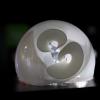
Leonardo at SIGGRAPH 2020

JUMP TO SCHEDULE OF EVENTS
Join Leonardo/ISAST at the annual SIGGRAPH conference this year
Once a year Leonardo publishes the SIGGRAPH journal issue, the result of an ongoing collaboration between Leonardo and ACM SIGGRAPH featuring global innovators who are changing what’s possible in computer graphics, animation, VR, Gaming, and Emerging Technologies.
SIGGRAPH 2020, the world’s leading showcase of digital and immersive art created using computer graphics and interactive techniques, will present a special Art Gallery that will offer a space for creative contemplation. In light of shifting ecological, political, social, and global-relations climates, artists examine the present and consider the question, “What can we do?”. The 47th SIGGRAPH conference will take place 17 August–28 August virtually. Beginning 17 August, on-demand content will be available. This will allow exploration, learning, and the opportunity for participants to review presentations in advance of interactive sessions with contributors beginning 24 August. Additionally, 24–28 August will include other various “can’t miss” scheduled sessions. All scheduled sessions take place in the Pacific Time Zone (UTC/GMT -7). For the convenience of participants, on-demand content will continue to be available for viewing through 27 October.
Join Leonardo this year at the SIGGRAPH 2020 conference and view the annual special Leonardo SIGGRAPH journal issue featuring new Art Papers and the Art Gallery (August 2020).
Art Papers
The vision of the Art Papers program at SIGGRAPH 2020 is built upon the interconnection with other arts-related paths inside SIGGRAPH. We will celebrate the Lifetime Achievement in Digital Art — several recipients have written influential papers in their fields, and it will be inspiring to build upon these publications with new ideas. Art Papers will also integrate with the Art Gallery — participants in the Art Papers track can be included in the Gallery, and we will host a joint session with Artist Presentations. Finally, in concert with Leonardo, we will investigate new possibilities for the publication and circulation of the Art Paper research.
Each year Leonardo journal publishes groundbreaking artists exploring the outer limits of emerging technologies presented with SIGGRAPH Art Papers and Art Gallery. Leonardo/ISAST is a global think tank that integrates transdisciplinary inquiry and creative practice to solve compelling problems, explore timeless mysteries, and shape a more excellent future.
Art Papers Chair
Andrés Burbano
Art Gallery
In the SIGGRAPH 2020 Art Gallery, attendees will revel in the experience of an interactive exhibition. Re-investigate this public art collection through the lens of new media that creates learning through ingenuity and exploration.
Art Gallery video presentation will be available on-demand beginning the week of 17-23 August. This allows registered attendees to watch presentations at their own pace, and formulate questions and discussion topics to be addressed during Q&A sessions, which are scheduled from 24-28 August.
On-demand content will continue to be available for viewing through 27 October.
Each year Leonardo journal publishes groundbreaking artists exploring the outer limits of emerging technologies presented with SIGGRAPH Art Papers and Art Gallery. Leonardo/ISAST is a global think tank that integrates transdisciplinary inquiry and creative practice to solve compelling problems, explore timeless mysteries, and shape a more excellent future.
Art Gallery Chair
Nik Apostolides
Leonardo Events at SIGGRAPH
SCHEDULE OVERVIEW
Tuesday 25 August
10:00–11:00 a.m. Art Papers: Culture and History Analytics
11:00–11:30 a.m. Art Papers: Culture and History Analytics Q&A
11:30 a.m.–12:00 p.m. Art Gallery: Fragmentation and Unity, the Dialogue of Analog and Virtual in Art
12:00–1:00 p.m. Art Papers: Genealogical Visualization, Intimate AI, and VR
11:00–1:30 p.m. Art Papers: Genealogical Visualization, Intimate AI, and VR Q&A
Wednesday 26 August
9:00–10:00 a.m. Art Papers: Crafts, Waves, Robots, and Pixels
10:00–10:30 a.m. Art Papers: Crafts, Waves, Robots, and Pixels Q&A
10:30–11:00 a.m. Art Gallery: Listen, Hear, Discern, Direct—Experiential Approaches to Art, Data and Virtuality
11:00 a.m.–12:00 p.m. Art Papers: Social Connections, Heritage, and Technological Realities
12:00–12:30 p.m. Art Papers: Social Connections, Heritage, and Technological Realities Q&A
1:00–2:00 p.m. Birds of a Feather: AI, Art and Social Justice
Birds of a Feather
AI, Art and Social Justice: Understanding and Addressing Bias, Representation and Inclusive Practices in the Development of AI Systems
Wednesday, 26 August 2020 at 1:00 p.m. PDT Details here
Hosted by: Andrés Burbano, ACM SIGGRAPH Digital Arts Community Committee Member and Art Papers Chair, and Ruth West, ACM SIGGRAPH Digital Arts Committee Community Member and Leonardo/LEAF Chair
What is the role of artists, engineers and computer graphics professionals in creating more equitable technologies for society? How can we ensure that inequalities are not transferred to and exacerbated in AI/ML algorithms, and that underserved communities benefit while having a say in how their data is collected and used? Join creative-AI practitioners and technologists for a lively dialogue on inclusive practices in the development and use of AI.
Speakers: Valencia James, Vernelle Noel, Nettrice Gaskins, Amelia Winger-Bearskin
Coorganized by: Leonardo/ISAST and ACM SIGGRAPH Digital Arts Committee (DAC)
AI, ART & SOCIAL JUSTICE S2020 from ACM SIGGRAPH on Vimeo.
Art Gallery
Fragmentation and Unity, the Dialogue of Analog and Virtual in Art
Tuesday, 25 August at 11:30 a.m.–12:00 p.m. PDT Details here
Presentations
Cacophonic Choir
Artists: Hannah E. Wolfe, Sölen Kiratli, Alex John Bundy
Description: “Cacophonic Choir,” an interactive art installation, addresses the ways that sexual assault survivors' experiences are distorted by digital and mass media and its effect.
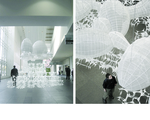
Algotecton
Artists: Daniel Cardoso Llach, Jingyang (Leo) Liu, Yi-Chin Lee
Description: "Algotecton" (from "algorithm" and "tecton" — carpentry, articulation) is a site-specific generative sculpture inspired by the Wearie-Phelan structure, a mathematical construct that approximates the geometry of foam.
![Still from Down Stream [Appalachia]](https://leonardo.info/sites/default/files/media-uploads/fgpmazwzppsvjnip.jpg)
Down Stream [Appalachia]
Artist: David Franusich
Description: "Down Stream [Appalachia]" addresses themes of ecological preservation, conservation, and connectedness.
The exhibition is composed of reflective, refractive sculptures and underwater video footage, surrounded by fully immersive spatial audio.
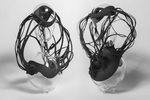
Glass Entanglement I and II
Artist: Tobias Klein
Description: Entanglement consists of two objects. Each is, on the one hand, a unique, handmade, traditionally crafted object — a glass-blown vessel, cut in two parts. Each, on the other, is a replicable, 3D-printed object based on 3D scanning the glass void space. They are entangled imitations of each other without being a copy.
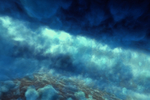
Homeostasis
Artist: Emil Polyak
Description: The project “Homeostasis” is a speculative, interactive visual experience. It is a metaphorical representation of human interference with data interpretations.
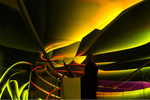
Myrioi
Artists: JoAnn Kuchera-Morin, Andres Cabrera, Kon Hyong Kim, Tim Wood, Gustavo Rincon
Description: "MYRIOI" is an interactive, immersive, shared narrative that drives the further evolution
of our AlloPortal/AlloSphere instrument/environment for artistic/scientific content exploration.
Listen, Hear, Discern, Reflect - Experiential Approaches to Art, Data and Virtuality
Wednesday, 26 August, 10:30 a.m.–11:00 a.m. PDT Details here
Presentations
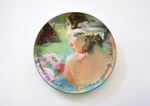
Captured by an Algorithm
Artist: Sophia Brueckner
Description: "Captured by an Algorithm" is a commemorative plate series that looks at romance novels through the lens of the Amazon Kindle’s Popular Highlight algorithm, telling the story of the loneliness, grief, vulnerability, and discontent felt by the readers.

Artist: Neil Mendoza
Description: "Disruptive Devices" is a triptych of digital kinetic artworks that mediate viewer interactions with virtual wildlife.
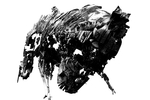
Dog of Zone
Artist: Łukasz Pazera
Description: This is an exploration of the concept of the "Zone" inspired by the "Roadside Picnic" novel written by Arkady and Boris Strugatsky, which is a search for individual artistic expression within a complex digital environment consisting of multiple medias.
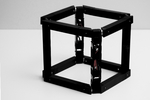
Inside Out
Artist: Yuichiro Katsumoto
Description: "Inside Out" is a kinetic installation that expresses the pointlessness of boundaries.
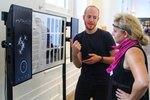 Ornamental
Ornamental
Artist: Luke Demarest
Description: In a reflection on data materialism in the digital age, "Ornamental" creates an emergent system of generative visualizations from live EEG brain data scanned in the gallery.
 The Skin
The Skin
Artists: Sanghwa Hong, Hyunchul Kim, Seonghyeon Kim, Byungjoo Leen
Description: "The Skin" uses an extremely sensitive touch surface that allows real-time measurements of eight properties for the object being contacted (stiffness, Young's modulus, static friction coefficient, kinetic friction coefficient, contact area, contact location, tangential force, normal force)
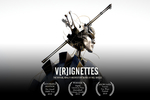 V[R]ignettes: A Microstory Series
V[R]ignettes: A Microstory Series
Artist: Mez Breeze
Description: "V[R]ignettes" is a series comprised of virtual reality-crafted microstories. Each individual microstory is designed to encourage a kind of "narrative smearing" – where traditional story techniques are truncated and mutated into smears (kinetic actions and mechanics, collage-like building blocks, visual distortions, dual-tiered annotations) which requires readers making active choices in order to navigate each microstory space (storybox)
Art Papers: Sessions
Culture and History Analytics
Tuesday, 25 August 2020, 10:00 a.m.–11:00 a.m. PDT Details here
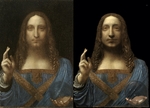 Inverse-rendering Based Analysis of the Fine Illumination Effects in the Salvator Mundi
Inverse-rendering Based Analysis of the Fine Illumination Effects in the Salvator Mundi
Authors: Marco(Zhanhang) Liang, Shuang Zhao, Michael T. Goodrich
Description: We have provided an inverse-rendering analysis that provides plausible optical explanations for the fine illumination effects in the Salvator Mundi. Our analysis supports Kemp’s main argument for authenticating the painting as Leonardo’s based on its optical accuracy and Leonardo’s study of optics.
 Cultural Viz: An Aesthetic Approach to Cultural Analytics
Cultural Viz: An Aesthetic Approach to Cultural Analytics
Authors: Everardo Reyes, Lev Manovich
Description: Cultural Analytics (C.A.) is an approach for analyzing media and digital culture using data methods and visual computing techniques. This paper explores the aesthetic value of C.A. by approaching cultural visualizations as digital artworks.
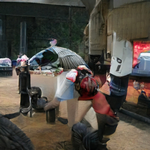 Visual Indeterminacy in GAN Art
Visual Indeterminacy in GAN Art
Author: Aaron Hertzmann
Description: We describe artwork based on GANs with the concept of visual indeterminacy, connecting them to art history and to the science of perception of art. GANs seem predisposed to producing indeterminate images; we hypothesize about why this is and where to go next.
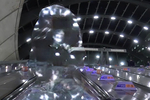 The Unknown Person
The Unknown Person
Author: Eddie Wong
Description: "The Unknown Person" uses mythotechnesis as a fictioning method to re-live a brutal incident in the artist's family history under colonial rule. Employing machine learning processes and facial recognition techniques, the artist interrogates surveillance and social control systems to explore the fiction of the self, data, and liminal spaces.
Q&A: Culture and History Analytics
Tuesday, 25 August 2020, 11:00–11:30 a.m. PDT Details here
Genealogical Visualization, Intimate AI, and VR
Tuesday, 25 August 2020, 12:00–1:00 p.m. PDT Details here
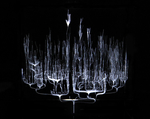 Enhanced Family Tree: Evolving Research and Expression
Enhanced Family Tree: Evolving Research and Expression
Authors: Fan Xiang, Shunshan Zhu, Zhigang Wang, Kevin Maher, Yi Liu, Yilin Zhu, Kaixi Chen, Zhiqiang Liang
Description: "Enhanced Family Tree" reimagines the possibilities of family trees with an evolving series of exhibits.
Their new approach may reveal questionable relationships in genealogical records.
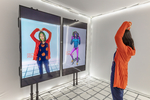 Stepping Inside the Classification Cube: An Intimate Interaction With an AI System
Stepping Inside the Classification Cube: An Intimate Interaction With an AI System
Authors: Avital Meshi and Angus Forbes
Description: The "Classification Cube" art installation invites participants to become familiar with a machine learning classification system which estimates their age, gender, emotion, and actions. Rapidly changing results encourage participants to actively perform their behavior to the system and alter the way it "sees" them.
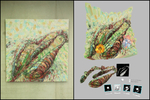 Rilievo: Artistic Scene Authoring via Interactive Height Map Extrusion in VR
Rilievo: Artistic Scene Authoring via Interactive Height Map Extrusion in VR
Authors: Sevinc Eroglu, Patric Schmitz, Carlos Aguilera Martinez, Jana Rusch, Leif Kobbelt, Torsten W. Kuhlen
Description: An authoring environment for artistic creation in VR enables the effortless conversion of 2D images into 3D objects. Artistic elements are extracted and relief sculpting is performed by mixing height maps generated from the input image. The tool is showcased in an analog-virtual workflow in collaboration with a traditional painter.
Q&A: Genealogical Visualization, Intimate AI, and VR
Tuesday, 25 August 2020, 1:00–1:30 p.m. PDT Details here
Crafts, Waves, Robots, and Pixels
Wednesday, 26 August 2020, 9:00–10:00 a.m. PDT Details here
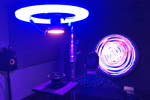 Resonant Waves: Immersed in Geometry
Resonant Waves: Immersed in Geometry
Authors: Richard Grillotti, Andy DiLallo, Angus Forbes
Description: "Resonant Waves" is a multisensory, immersive, interactive cymatic art installation/experience. This project reveals the natural phenomenon of sound and vibration as it forms intricate visual geometric patterns in water.
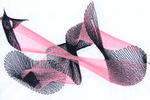 Hybrid Embroidery: Exploring Interactive Fabrication in Hand Crafts
Hybrid Embroidery: Exploring Interactive Fabrication in Hand Crafts
Authors: Yi-Chin Lee, Daniel Cardoso Llach
Description: "Hybrid Embroidery" is a framework for interactive fabrication that leverages the potential of computation to broaden the possibilities of the craft of embroidery. "Hybrid Embroidery" is set out to offer an example of how computational methods may enrich craft and refining technical interactions to support expressiveness and open-ended practice.
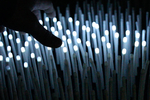 Animated Robotic Sculptures: Using SMA Motion Display to Create Lifelike Movements
Animated Robotic Sculptures: Using SMA Motion Display to Create Lifelike Movements
Author: Akira Nakayasu
Description: Animated robotic sculptures are works of art that combine plant and animal motifs with robotics to give their audience a sense of the objects being alive through their lifelike movements, such as stirring leaves or squirming tentacles.
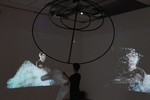 Pixel of Matter: New Ways of Seeing With an Active Volumetric Filmmaking System
Pixel of Matter: New Ways of Seeing With an Active Volumetric Filmmaking System
Authors: Seonghoon Ban and Kyung Hoon Hyun
Description: We introduce an installation art project using the active volumetric filmmaking technology to investigate its possibilities in art practice. To do that, we developed a system to film volumetric video in real time, thereby allowing its users to capture large environments and objects without fixed placement or preinstallation of cameras.
Q&A: Crafts, Waves, Robots, and Pixels
Wednesday, 26 August 2020, 10:00–10:30 a.m. PDT Details here
Social Connections. Heritage, and Technological Realities
Wednesday, 26 August 2020, 11:00 a.m. –12:00 p.m. PDT Details here
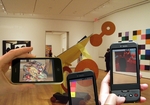 REALational Perspectives: Strategies for Expanding Beyond the Here-and-Now in Mobile Augmented Reality (AR) Art
REALational Perspectives: Strategies for Expanding Beyond the Here-and-Now in Mobile Augmented Reality (AR) Art
Author: Liron Efrat
Description: This paper analyzes AR installations to demonstrate different strategies for producing a relational sense of place and time. By exposing actual environments as constructed (and, therefore, as virtual) landscapes, AR art exposes our situatedness and becomes
a strong tool for activism that encourages us to think beyond familiar reality.
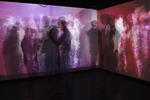 Body RemiXer: Extending Bodies to Stimulate Social Connection in an Immersive Installation
Body RemiXer: Extending Bodies to Stimulate Social Connection in an Immersive Installation
Authors: John Desnoyers-Stewart, Ekaterina R. Stepanova, Bernhard E. Riecke, Patrick Pennefather
Description: "Body RemiXer" is a mixed reality installation that connects immersants using a virtual reality headset, Kinect, and projections. It explores the potential of immersive technology to create co-present experiences that foster intercorporeality between immersants.
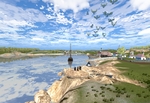 Artistic License in Heritage Visualisation: VR Sydney Cove Circa 1800
Artistic License in Heritage Visualisation: VR Sydney Cove Circa 1800
Author: Kit Devine
Description: This work provokes and broadens debate about heritage at individual, institutional, academic, and societal levels. It foregrounds the assumptions that underlie heritage visualizations, and it offers a novel interpretation model for museum settings that engages with different audiences and encourages debate as to the nature and uses of heritage.
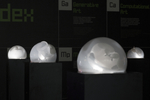 Cacophonic Choir
Cacophonic Choir
Authors: Şölen Kıratlı, Hannah E. Wolfe, Alex Bundy
Description: “Cacophonic Choir,” an interactive art installation, addresses the ways that sexual assault survivors' experiences are distorted by digital and mass media and its effect. The installation is composed of distributed agents in space that individually respond by becoming visually bright, semantically coherent, and sonically clear, revealing original testimonies of survivors.
Q&A: Social Connections. Heritage, and Technological Realities
Wednesday, 26 August 2020, 12:00–12:30 p.m. PDT Details here


